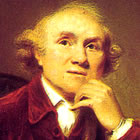
Charles Dotter, MD in LIFE Magazine, August 1964
Angioplasty! A word at the center of the recent TCT meeting in Miami, attended by 12,000 healthcare professionals. A word coined half-a-century ago by Dr. Charles Dotter, a radiologist who practiced at Oregon Health & Science University in Portland, Oregon.
Dotter’s idea was simple: to open up arterial blockages in the legs from the inside out: by snaking a catheter down the circulatory system to the blockage, instead of cutting through the various layers of body tissue to repair the artery through open surgery.
Pictured here is Dr. Dotter, as shown in a LIFE magazine feature from August 14, 1964. If he looks a bit crazed, well…that is the way he was depicted. There are more photos in the complete story here, and in each one he looks increasingly like the mad scientist from a Saturday matinee sci-fi double feature. (More on the sci-fi connection later.)
Suffice it to say that in 1964 the mere idea that one could open up a blocked artery from the inside out was blasphemy to the surgical community. Dotter and the vascular surgeons of his day were at opposite ends of the therapeutic spectrum. The surgeons thought that Dotter (who they dubbed, “Crazy Charlie”) was promoting dangerous and unsubstantiated procedures. They criticized him at every turn and blocked his ideas from spreading. And, according to Enid Ruble, Dotter’s secretary, the photos used in the LIFE story hurt Dr. Dotter considerably. After all, he was just trying to develop a less invasive alternative to open surgery.

John Hunter 1728–1793
Did I say “alternative to surgery?”
Flashback…200 years ago! Englishman John Hunter, considered the founder of “scientific surgery” and the first physician to treat an aneurysm successfully, wrote the following in his 1777 treatise, “The True Principles of Surgery”:
“This last part…namely operations…is a tacit acknowledgement of the insufficiency of surgery. It is like an armed savage who attempts to get that by force which a civilized man would get by stratagem.”
Hunter is revered as the father of vascular surgery. His portrait was part of the logotype for the Society of Vascular Surgery. Yet 200 years ago, he equated surgery with “savagery” and opined that perhaps there was a better way than force…a more “civilized stratagem!”
Well…Dotter conceived of that stratagem, and he called it “angioplasty.” But it went nowhere in the United States, because of the power of the status quo and the opposition of the surgical community. He successfully performed procedures on a number of patients, but only a few physicians in Europe seemed interested. One was Dr. Eberhard Zeitler, a German radiologist who traveled to Portland, learned Dotter’s technique, and brought it back to Europe. He organized courses in the early 70’s to teach the procedure. One of these courses was attended by a young German angiologist, working in Zurich. His name was Andreas Gruentzig and his addition of a balloon to Dotter’s catheter system revolutionized the procedure. He started in the legs, but soon moved to the heart and in 1977 performed the first coronary angioplasty in the catheterization laboratory: he opened a blocked coronary artery…without surgery!
* * * * * *
So what was some of the big news at this year’s TCT meeting? The use of catheter-based procedures in the peripheral vessels: the legs, the kidneys. Some of the major newsworthy device stories were concerned with drug-eluting balloons and stents and new atherectomy devices for opening the leg arteries, not to mention renal denervation procedures in the kidneys to lower refractory high blood pressure. There is even a research initiative looking at the “carotid body”, located at the fork of the carotid artery, which may be involved in treating a host of sympathetic nervous system maladies from blood pressure to heart failure to diabetes.
There are a number of device manufacturers and startups working in this space: Medtronic, Cook, Covidien, Boston Scientific, Cibiem, to name a few. In fact, today, the FDA approved Cook’s Zilver stent, the first drug-eluting stent for use in the peripheral arteries (also interesting — Bill Cook, the founder of Cook Medical, worked closely with Charles Dotter, fashioning and manufacturing the first equipment used for angioplasty).
We’ll be detailing some of these promising treatments in future articles. But the main thought here is that a simple idea which started very modestly half-a-century ago to treat peripheral disease in the legs, took a journey to the heart, and is now being studied intensely again to solve the problem of critical limb ischemia.
* * * * * *
Oh yeah — the sci-fi connection. I discussed this several years ago in my blog post, “Fantastic Voyage”: Truth is Stranger.” Interventional cardiologists always like to refer to the 1966 movie “Fantastic Voyage,” in which a crew of men AND Raquel Welch are shrunk and injected into a human body to navigate their odd Jules Verne-like vessel to the subject’s brain where they laser-zap-zap a blood clot and save a world-famous scientist. How amazing, they say, that this film was able to predict the entire endovascular revolution in medicine. (In fact, just this morning, Dr. Paul Teirstein referenced the movie in an article about intravascular ultrasound.) But, as I’ve written, it’s always been my belief that Jerome Bixby, the Hollywood screenwriter, got the idea from the LIFE magazine article about Charles Dotter, so angioplasty inspired the movie “Fantastic Voyage”, not the other way around.
And speaking of movies, Charles Dotter was an amateur movie-maker himself and when he was inventing angioplasty, he also made a movie about it, which he took with him to meetings all over the world. Here’s a brief excerpt from Dotter’s 1965 movie, “Transluminal Angioplasty”, for your viewing pleasure (note that Dotter narrates the film himself…and — spoiler alert — check out his prediction at the end!):



